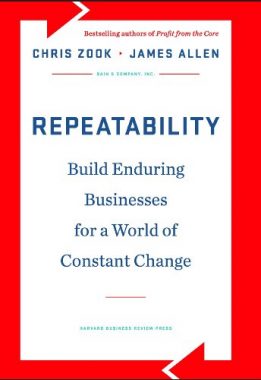Disrupting Acquisition Blog
Repeatability: DoD Innovation in a World of Constant Change
 Leading business strategy consultants Chris Zook and James Allen co-authored Repeatability: Build Enduring Businesses for a World of Constant Change. After studying over 200 companies, some of the core lessons they captured in Repeatability include:
Leading business strategy consultants Chris Zook and James Allen co-authored Repeatability: Build Enduring Businesses for a World of Constant Change. After studying over 200 companies, some of the core lessons they captured in Repeatability include:
- Complexity kills speed, responsiveness, and ultimately growth.
- Strategy is now much less about a detailed plan than about a general direction and a few critical initiatives—almost a strategy on a page—built around deep capabilities that can be constantly improved, adapted, and reapplied.
- Strategy is now less about anticipating how the world will change, which is increasingly difficult to know, than about superiority at rapid testing, learning, changing, and adapting.
- Effective strategy is becoming increasingly indistinguishable from an effective organization.
- Data shows that simplicity, focus, and mastering the art of continuous change nearly always trump strategies of radical change or constant reinvention.
- Long-term success actually requires a foundation of enduring and stable core principles.
- Differentiation is the essence of strategy, the root cause of competitive advantage, and a major driver of relative profitability among businesses.
- Two prominent reasons why once seemingly invincible business models lost momentum are loss of focus on the core and failure to adapt rapidly enough.
- Simplicity of the business model enables responsiveness.
- When you boil it down, simplicity, focus, and repeatability are at the heart of everything.
Anyone who has been involved in defense acquisition for more than five minutes understands its complexity. DoD’s requirements, acquisition, and budget processes are the epitome of government bureaucracy. DoD leaders have captured in the National Defense Strategy and regular statements the need for speed and responsiveness in a changing world to maintain military superiority in the future.
DoD, with the help of Congress, has been taking bold steps to reduce the complexity in acquisition. An Adaptive Acquisition Framework has many tailorable acquisition pathways to acquire and deliver capabilities. The new Middle Tier of Acquisition pathway is popular with acquisition executives and program managers who view it as a prime opportunity to start fast. This enables programs to focus on rapidly prototyping solutions instead of the bureaucratic acquisition documents, reviews, and processes. DoD also has an array of FAR and Non-FAR contracting strategies to select from in the Contracting Cone, including the popular Other Transactions, and best kept secret 10 USC 2373.
Yet many acquisition professionals are unaware of these changes. To all the acquisition professionals reading this, let me ask you a few simple questions:
- Do you have detailed requirements documents that can take up to two years to get approved via the JCIDS processes or can you simply convey the capabilities needed to achieve a set of mission objectives?
- Are you planning to spend years analyzing alternatives, predicting operations, threats, and technologies decades from now, and prematurely defining a system solution?
- Do you have detailed acquisition strategies and the massive amount of documentation required by law and policy, that must be coordinated by many, many oversight organizations?
- Five years from now when the world has changed and your strategies are focused on the wrong thing, how much time did you waste and how much will you really course correct? What will the Warfighters say when the capabilities you deliver don’t address current needs?
- Can you develop a simple plan to rapidly prototype, experiment, and demonstrate capabilities to learn and adapt acquisition strategies and technical solutions?
- Do you have the standard program office model of 100+ acquisition professionals performing similar roles as those 20 years ago or do you have a dynamic organization build around a core set of people and repeatable processes with a culture focused on accelerating capability deliveries?
Disclaimer: The opinions expressed here are those of the authors only and do not represent the positions of the MITRE Corporation or its sponsors.
Subscribe to Our Newsletter


0 Comments